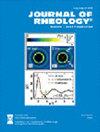High-frequency optimally windowed chirp rheometry for rapidly evolving viscoelastic materials: Application to a crosslinking thermoset
IF 3
2区 工程技术
Q2 MECHANICS
引用次数: 0
Abstract
Knowledge of the evolution in the mechanical properties of a curing polymer matrix is of great importance in composite parts or structure fabrication. Conventional rheometry, based on small amplitude oscillatory shear, is limited by long interrogation times. In rapidly evolving materials, time sweeps can provide a meaningful measurement albeit at a single frequency. To overcome this constraint, we utilize a combined frequency- and amplitude-modulated chirped strain waveform in conjunction with a homemade sliding plate piezo-operated rheometer (PZR) and a dual-head commercial rotational rheometer (Anton Paar MCR 702) to probe the linear viscoelasticity of these time-evolving materials. The direct controllability of the PZR, resulting from the absence of any kind of firmware and the microsecond actuator-sensor response renders this device ideal for exploring the advantages of this technique. The high frequency capability allows us to extend the upper limits of the accessible linear viscoelastic spectrum and, most importantly, to shorten the length of the interrogating strain signal (OWCh-PZR) to subsecond scales, while retaining a high time-bandwidth product. This short duration ensures that the mutation number (NMu) is kept sufficiently low, even in fast-curing resins. The method is validated via calibration tests in both instruments, and the corresponding limitations are discussed. As a proof of concept, the technique is applied to a curing vinylester resin. The linear viscoelastic (LVE) spectrum is assessed every 20 s to monitor the rapid evolution in the time and frequency dependence of the complex modulus. Comparison of the chirp implementation, based on parameters such as duration of the experiment, sampling frequency, and frequency range, in a commercial rotational rheometer with the PZR provides further information on the applicability of this technique and its limitations. Finally, FTIR spectroscopy is utilized to gain insights into the evolution of the chemical network, and the gap dependence of the evolving material properties in these heterogeneous systems is also investigated.用于快速变化粘弹性材料的高频优化窗口啁啾流变仪:交联热固性材料的应用
了解固化聚合物基体机械性能的变化对复合材料部件或结构的制造非常重要。传统的流变仪以小振幅振荡剪切为基础,受到询问时间长的限制。对于快速发展的材料,时间扫描可以提供有意义的测量,尽管是在单一频率下。为了克服这一限制,我们将频率和振幅调制的啁啾应变波形与自制的滑板压电流变仪(PZR)和双头商用旋转流变仪(Anton Paar MCR 702)结合使用,以探测这些随时间变化的材料的线性粘弹性。PZR 不需要任何固件就能直接控制,而且微秒级的致动器-传感器响应使其成为探索该技术优势的理想设备。高频能力使我们能够扩展可访问的线性粘弹性频谱的上限,最重要的是,在保留高时间带宽乘积的同时,将询问应变信号(OWCh-PZR)的长度缩短到亚秒级。这种较短的持续时间确保了即使在快速固化树脂中也能保持足够低的突变数 (NMu)。该方法通过两种仪器的校准测试进行了验证,并讨论了相应的局限性。作为概念验证,该技术被应用于固化乙烯基酯树脂。每 20 秒评估一次线性粘弹性(LVE)频谱,以监测复模量随时间和频率的快速变化。根据实验持续时间、采样频率和频率范围等参数,将商用旋转流变仪中的啁啾实施与 PZR 进行比较,可进一步了解该技术的适用性及其局限性。最后,还利用傅立叶变换红外光谱深入了解了化学网络的演变,并研究了这些异质系统中不断演变的材料特性的间隙依赖性。
本文章由计算机程序翻译,如有差异,请以英文原文为准。
求助全文
约1分钟内获得全文
求助全文
来源期刊

Journal of Rheology
物理-力学
CiteScore
6.60
自引率
12.10%
发文量
100
审稿时长
1 months
期刊介绍:
The Journal of Rheology, formerly the Transactions of The Society of Rheology, is published six times per year by The Society of Rheology, a member society of the American Institute of Physics, through AIP Publishing. It provides in-depth interdisciplinary coverage of theoretical and experimental issues drawn from industry and academia. The Journal of Rheology is published for professionals and students in chemistry, physics, engineering, material science, and mathematics.
 求助内容:
求助内容: 应助结果提醒方式:
应助结果提醒方式:


